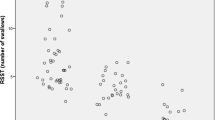Abstract
The frequency of spontaneous swallowing is useful for screening of dysphagia in acute stroke. Low levels of substance P (SP) in saliva attenuate the swallowing reflex. The aim of this study was to determine the relationship between the frequency of spontaneous swallowing and salivary SP levels. In 40 subjects, saliva was collected within 72 h after stroke onset and salivary SP levels were measured using ELISA kit at a later date. The frequency of spontaneous swallowing was measured over 1 h using a microphone placed on the neck. Pneumonia was diagnosed by the presence of pyrexia and at least two respiratory problems of four categories (sputum, cough or breathing pattern, breath sound, and gas change). The presence of detectable levels of SP in the saliva was confirmed in 17 patients (high SP group), whereas the level was below the detection limit of the ELISA kit in 23 patients (low SP group). The frequency of spontaneous swallowing was significantly lower in low SP group (16.1 ± 11.6 per hour) than in the high SP group (30.4 ± 20.4, p = 0.016). As the result of multiple regression analysis, salivary SP levels were correlated with frequency of spontaneous swallowing independently of age, NIHSS, and GCS. The incidence of pneumonia was significantly higher in the low than high SP group (p < 0.001). In conclusion, the frequency of spontaneous swallowing was decreased in acute stroke patients with low salivary SP levels. Salivary SP levels can be potentially a useful biomarker of risk of stroke-associated pneumonia in the acute stage.

Similar content being viewed by others
References
Cohen DL, Roffe C, Beavan J, et al. Post-stroke dysphagia: a review and design considerations for future trials. Int J Stroke. 2016;11:399–411.
Crary MA, Carnaby GD, Sia I, Khanna A, Waters MF. Spontaneous swallowing frequency has potential to identify dysphagia in acute stroke. Stroke. 2013;44:3452–7.
Arai T, Yoshimi N, Fujiwara H, Sekizawa K. Serum substance P concentrations and silent aspiration in elderly patients with stroke. Neurology. 2003;61:1625–6.
Nakagawa T, Ohrui T, Sekizawa K, Sasaki H. Sputum substance P in aspiration pneumonia. Lancet. 1995;345:1447.
Nakagawa T, Sekizawa K, Arai H, Kikuchi R, Manabe K, Sasaki H. High incidence of pneumonia in elderly patients with basal ganglia infarction. Arch Intern Med. 1997;157:321–4.
Ship JA, Pillemer SR, Baum BJ. Xerostomia and the geriatric patient. J Am Geriatr Soc. 2002;50:535–43.
Nishino T, Takizawa K, Yokokawa N, Hiraga K. Depression of the swallowing reflex during sedation and/or relative analgesia produced by inhalation of 50% nitrous oxide in oxygen. Anesthesiology. 1987;67:995–8.
Arai T, Yasuda Y, Takaya T, Toshima S, Kashiki Y, Yoshimi N, Fujiwara H. ACE inhibitors and symptomless dysphagia. Lancet. 1998;352:115–6.
Tanaka N, Nohara K, Okuno K, Kotani Y, Okazaki H, Matsumura M, Sakai T. Development of a swallowing frequency meter using a laryngeal microphone. J Oral Rehabil. 2012;39:411–20.
Takahashi K, Groher ME, Michi K. Methodology for detecting swallowing sounds. Dysphagia. 1994;9:54–62.
Lyden P, Brott T, Tilley B, et al. Improved reliability of the NIH stroke scale using video training. NINDS TPA stroke study group. Stroke. 1994;25:2220–6.
Adams HP Jr, Bendixen BH, Kappelle LJ, et al. Classification of subtype of acute ischemic stroke. Definitions for use in a multicenter clinical trial. TOAST. Trial of org 10172 in acute stroke treatment. Stroke. 1993;24:35–41.
Wilson JT, Hareendran A, Hendry A, et al. Reliability of the modified Rankin scale across multiple raters: benefits of a structured interview. Stroke. 2005;36:777–81.
Crary MA, Mann GD, Groher ME. Initial psychometric assessment of a functional oral intake scale for dysphagia in stroke patients. Arch Phys Med Rehabil. 2005;86:1516–20.
Smith CJ, Kishore AK, Vail A, et al. Diagnosis of stroke-associated pneumonia: recommendations from the pneumonia in stroke consensus group. Stroke. 2015;46:2335–40.
Faul F, Erdfelder E, Lang AG, et al. G*Power 3: a flexible statistical power analysis program for the social, behavioral, and biomedical sciences. Behav Res Methods. 2007;39:175–91.
Suntrup-Krueger S, Bittner S, Recker S, Meuth SG, Warnecke T, Suttrup I, Marian T, Dziewas R. Electrical pharyngeal stimulation increases substance P level in saliva. Neurogastroenterol Motil. 2016;28:855–60.
He M, Ohrui T, Azumi M, Ida S, Sasaki H. Depressed involuntary swallowing and risk of pneumonia. J Am Geriatr Soc. 2004;52:1032–3.
Funding
This study was funded partly by Tokyo Metropolitan Clinical Research Grant (No. H27040308).
Author information
Authors and Affiliations
Corresponding author
Ethics declarations
Ethical Approval
All procedures performed in studies involving human participants were in accordance with the ethical standards of the institutional and/or national research committee and with the 1964 Helsinki declaration and its later amendments or comparable ethical standards.
Rights and permissions
About this article
Cite this article
Niimi, M., Hashimoto, G., Hara, T. et al. Relationship Between Frequency of Spontaneous Swallowing and Salivary Substance P Level in Patients with Acute Stroke. Dysphagia 33, 414–418 (2018). https://doi.org/10.1007/s00455-017-9867-2
Received:
Accepted:
Published:
Issue Date:
DOI: https://doi.org/10.1007/s00455-017-9867-2




